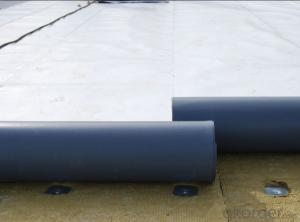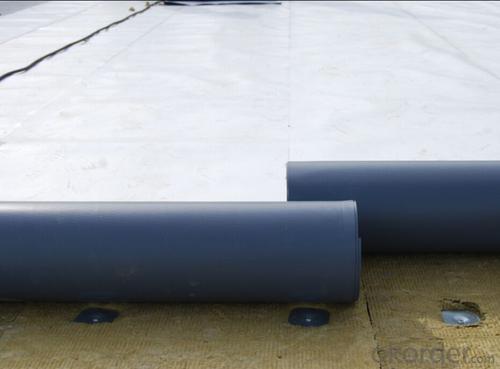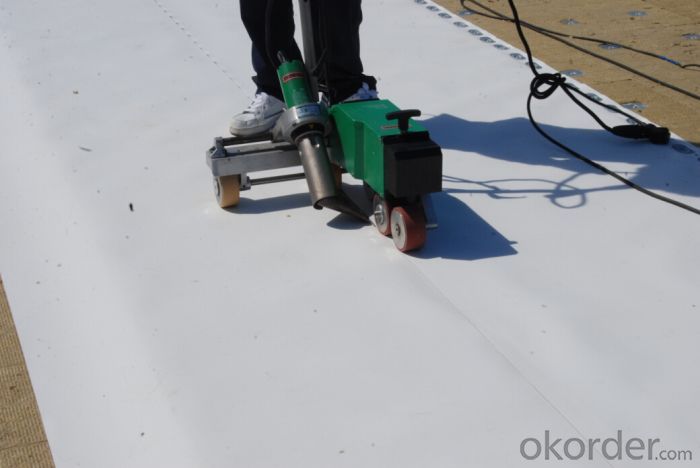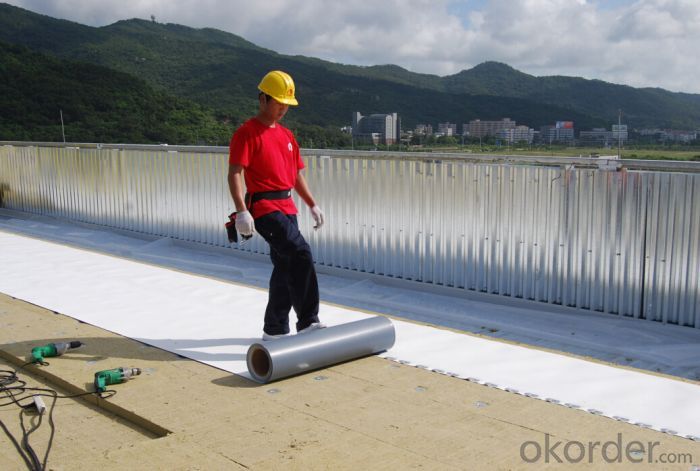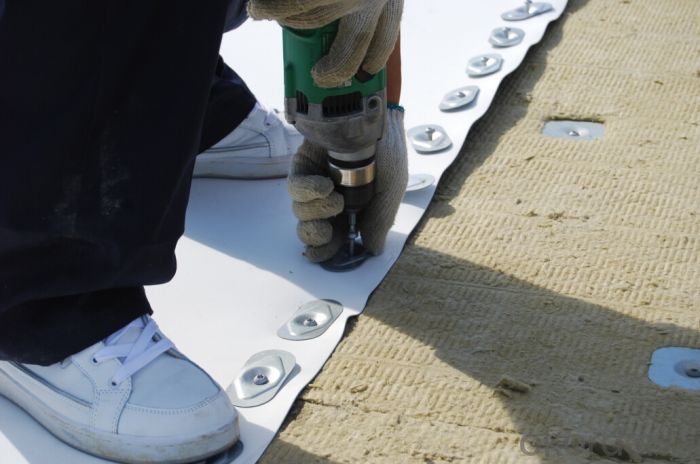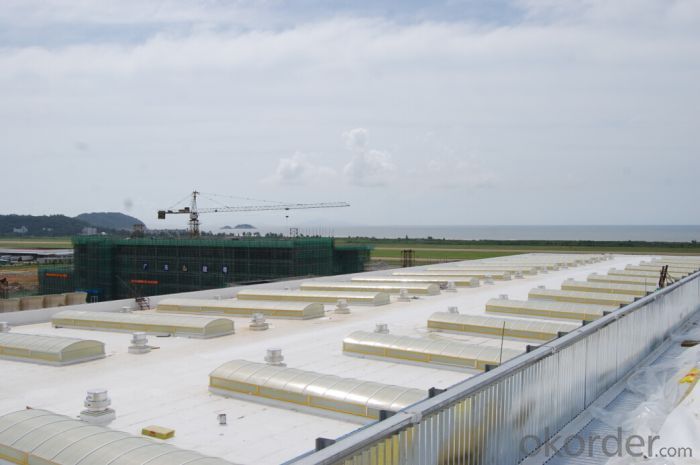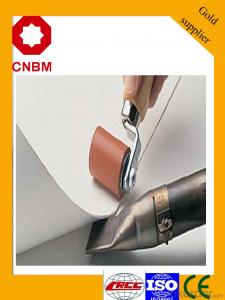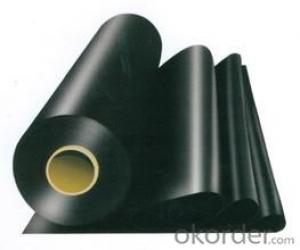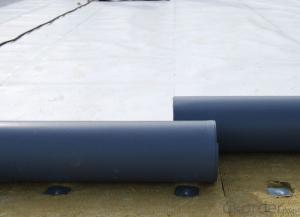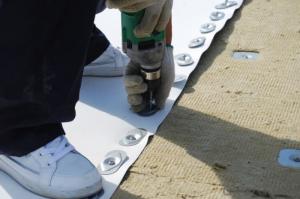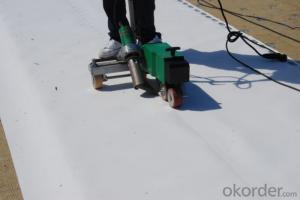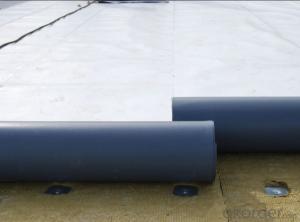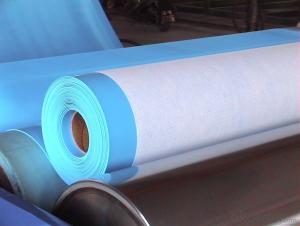TPO Waterproof Roofing Membrane 1.2 mm with Good Quality
- Loading Port:
- China Main Port
- Payment Terms:
- TT or LC
- Min Order Qty:
- 5000 m²
- Supply Capability:
- 100000 m²/month
OKorder Service Pledge
OKorder Financial Service
You Might Also Like
TPO Waterproof Membrane
TPO is a waterproofing sheet, consisting of thermoplastic polyolefin, and compound resin materials as the base stock, reinforced with polyester mesh fabric.
Product Applications:
Widely used in all kinds of building roof(exposed roof,planting roof,driving roof,light steel roof) and basement,tunnel,grain depot,subway,reservoir,etc.
Product Advantages:
1. Weather resistance and durability; Excellent weld ability;
2. No any crisp agents to prevent materials brittleness;
3. Intermediate enhanced polyester mesh fabric to have high tensile strength, fatigue resistance and penetrating resistance suitable for mechanically attached roofing systems;
4. Excellent the same high and low temperature resistance as rubber materials which can keep flexible at -50° C and keep mechanical strength in high temperature;
Main Product Features:
1.. Excellent chemical resistance to acids, bases, and restaurant exhaust emissions; Dimension stability;
2.. White-based light-color and smooth surface with high reflection, energy saving and anti-dust functions;
3. Use heat welding for the seam areas to form a reliable seamless waterproof layer.
Product Specifications:
Thickness: 1.2mm and 1.5mm
Item | Requirement | Test Method | ||
Thickness, min, mm | Sheet-overall | ≥1.0 | ASTM D6878 | |
Coating over fabric or scrim, weathering side only | ≥0.305 | ASTM D751 | ||
Breaking strength, min, N | ≥976 | ASTM D751 | ||
Elongation at reinforcement break, min, % | ≥15 | ASTM D751 | ||
Tearing strength,min, N | ≥245 | ASTM D751 | ||
Brittleness point, max, °C | ≤-40 | ASTM D2137 | ||
Ozone resistance | no cracks | ASTM D1149 | ||
Properties after heat aging | Breaking strength, % min | ≥90 | ASTM D573 | |
Elongation at reinforcement break, % min | ≥90 | ASTM D573 | ||
Tearing strength, % min | ≥60 | ASTM D573 | ||
Weight change (mass), max % | ≤±1 | ASTM D573 | ||
Linear dimensional change, max, % | ≤±1 | ASTM D1204 | ||
Water absorption, max, mass % | ≤±3.0 | ASTM D471 | ||
Factory seam strength, min, N | ≥290 | ASTM D751 | ||
Weather resistance | Visual inspection | - | ||
FAQ:
Q: Can I visit your company?
A: Yes, welcome to visit our enterprise.
Q: Can I do the third party testing before loading?
A: Yes, we could accept the third party testing.
Q: Which kind of payment in your company?
A: We could accept TT, LC at sight, etc.
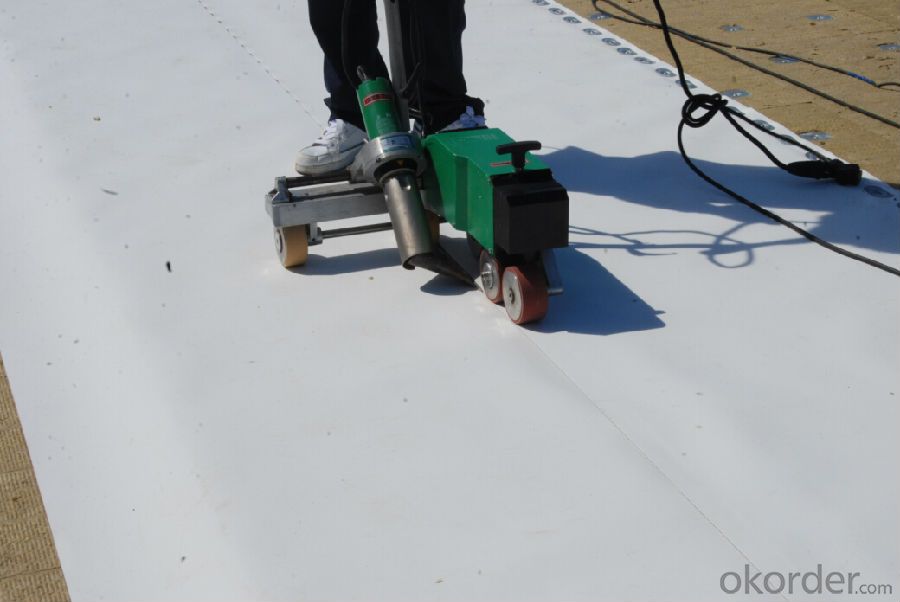
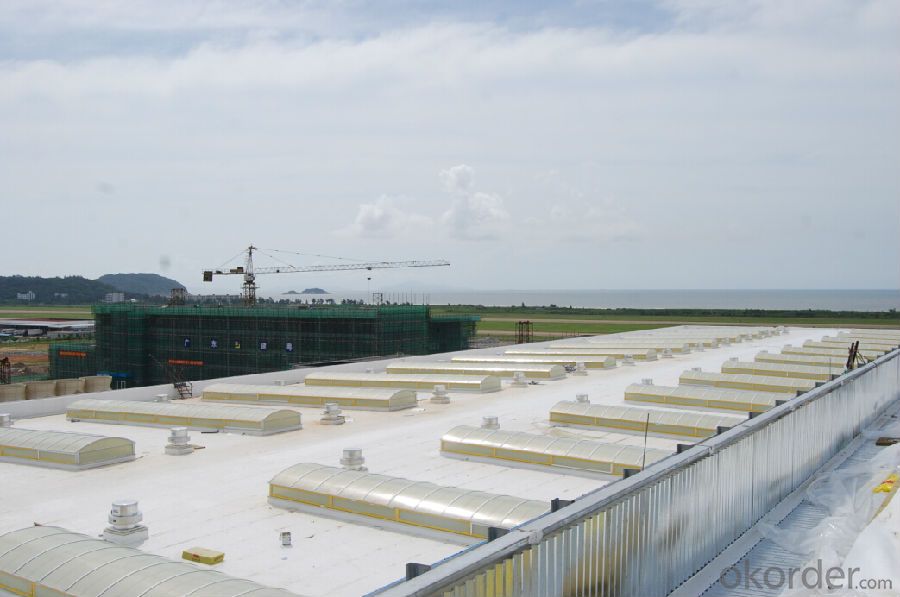

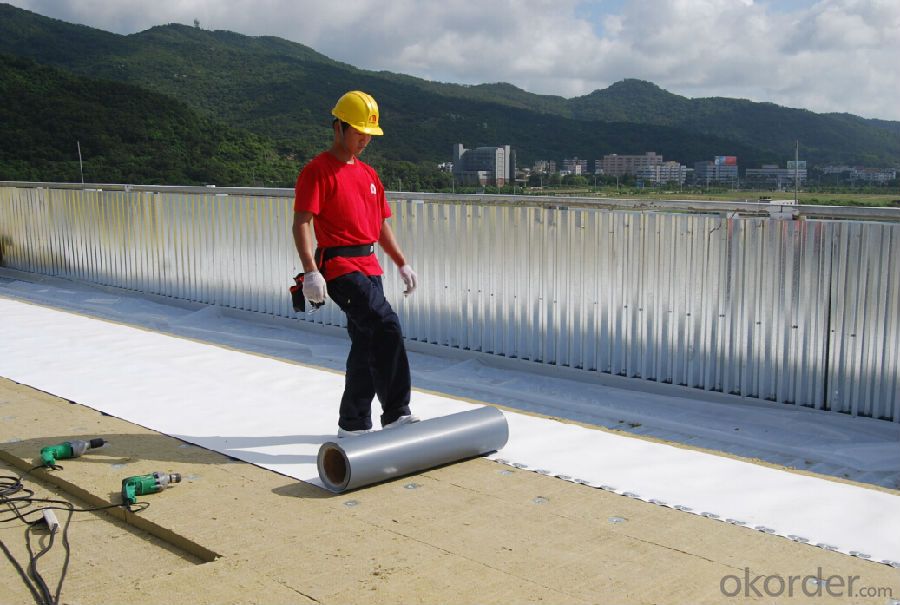
- Q: Coil waterproof roofing requirements
- 3, More than 50, the polymer membrane R is greater than 20
- Q: Does a waterproofing membrane provide any insulation against temperature fluctuations?
- No, a waterproofing membrane does not provide any insulation against temperature fluctuations. Its primary function is to prevent water infiltration and protect the underlying structure from moisture damage.
- Q: Can a waterproofing membrane be used on EPDM roofs?
- EPDM roofs can benefit from the use of a waterproofing membrane. This synthetic rubber roofing material, known as EPDM, is popular for low-slope and flat roofs due to its durability and flexibility. Although EPDM roofs are already waterproof, adding a waterproofing membrane can offer an added layer of defense, increasing the roof's lifespan. By acting as a barrier against water infiltration, the waterproofing membrane prevents leaks and moisture-related harm. Nonetheless, it is crucial to guarantee that the chosen waterproofing membrane is compatible with EPDM and installed according to the manufacturer's instructions to preserve the roof's integrity.
- Q: Can a waterproofing membrane be used for train platforms?
- Yes, a waterproofing membrane can be used for train platforms. Train platforms are exposed to various weather conditions, including rain and snow, which can cause water damage and deterioration over time. By installing a waterproofing membrane on the surface of the train platform, it creates a protective barrier that prevents water from seeping through and causing damage to the underlying structure. This helps to extend the lifespan of the platform, reduce maintenance costs, and ensure the safety of passengers and personnel. Additionally, a waterproofing membrane can also help to prevent the growth of mold and mildew, which can be detrimental to the health of individuals using the train platform. Overall, using a waterproofing membrane on train platforms is a practical and effective solution to protect against water damage and maintain the longevity of the infrastructure.
- Q: Can a waterproofing membrane be painted or covered with other materials?
- Yes, a waterproofing membrane can be painted or covered with other materials. However, it is important to ensure that the paint or covering material used is compatible with the membrane and does not compromise its waterproofing properties. It is recommended to consult the manufacturer's guidelines or seek professional advice to ensure proper application and maintenance of the waterproofing membrane.
- Q: Can a waterproofing membrane be applied over cracks or joints in a surface?
- Cracks or joints in a surface can indeed have a waterproofing membrane applied over them. In fact, it is often advisable to do so to guarantee a thorough and efficient waterproofing system. The membrane serves as a barrier, preventing water from penetrating the cracks or joints and causing harm to the underlying structure. However, it is crucial to acknowledge that the cracks or joints must be adequately repaired and prepared prior to the application of the waterproofing membrane. This might entail cleaning, filling, and sealing the cracks or joints to ensure proper adherence of the membrane and the provision of a continuous and watertight seal. Moreover, the selection of the appropriate waterproofing membrane should be based on the specific requirements and conditions of the surface being treated.
- Q: Can a waterproofing membrane be used in conjunction with sustainable construction materials?
- Yes, a waterproofing membrane can be used in conjunction with sustainable construction materials. In fact, incorporating sustainable construction materials is increasingly becoming a priority in the construction industry due to the need for more environmentally friendly and energy-efficient buildings. Waterproofing membranes can be used to protect sustainable construction materials, such as recycled or low-impact materials, from water damage and moisture infiltration. These membranes create a barrier that prevents water from seeping through the materials, thus prolonging their lifespan and reducing the need for repair or replacement. Additionally, sustainable construction materials are often designed to be more energy-efficient, which can be further enhanced by using a waterproofing membrane. By preventing water damage, the membrane helps maintain the integrity of the building envelope, reducing the potential for energy loss through leaks or moisture intrusion. Moreover, some waterproofing membranes are specifically designed to be more sustainable themselves. For instance, there are eco-friendly membranes made from recycled materials or those that can be recycled at the end of their lifespan. These sustainable membranes minimize the environmental impact associated with their production and disposal. Overall, utilizing a waterproofing membrane in conjunction with sustainable construction materials is a smart and responsible approach to building design. It ensures the long-term durability and performance of the materials, while also contributing to a more sustainable and energy-efficient built environment.
- Q: Can a waterproofing membrane be used on precast zinc surfaces?
- Precast zinc surfaces can indeed benefit from the use of a waterproofing membrane. These membranes are specifically designed to safeguard various surface types against water infiltration, including concrete, metal, and zinc. By creating a protective barrier, these membranes effectively prevent water from permeating the surface. This is especially crucial for precast zinc surfaces that are prone to exposure to moisture or water. The application of a waterproofing membrane to such surfaces can effectively extend their lifespan and shield them against potential water-induced damage, such as corrosion or deterioration. Therefore, it is essential to carefully choose a waterproofing membrane that is compatible with zinc and meticulously adhere to the manufacturer's instructions regarding proper application and maintenance.
- Q: Are waterproofing membranes resistant to rodent and insect infestation?
- Waterproofing membranes are generally not specifically designed to be resistant to rodent and insect infestation. While they may provide a barrier against water and moisture, they may not necessarily prevent rodents and insects from accessing or damaging the membrane. It is advisable to take additional measures, such as using pest control methods or installing barriers, to effectively address rodent and insect infestation issues.
- Q: Can a waterproofing membrane be used for a plaza deck?
- Yes, a waterproofing membrane can be used for a plaza deck. A plaza deck is a flat surface that is usually elevated and exposed to various weather conditions, such as rain, snow, and sunlight. Waterproofing membranes are designed to provide a barrier against water penetration and protect the underlying structure from moisture damage. They are commonly used in outdoor applications, including plaza decks, to prevent water infiltration into the building or structure below. By installing a waterproofing membrane on a plaza deck, it helps to ensure the longevity and durability of the deck, while also providing a safe and dry environment for pedestrians.
Send your message to us
TPO Waterproof Roofing Membrane 1.2 mm with Good Quality
- Loading Port:
- China Main Port
- Payment Terms:
- TT or LC
- Min Order Qty:
- 5000 m²
- Supply Capability:
- 100000 m²/month
OKorder Service Pledge
OKorder Financial Service
Similar products
Hot products
Hot Searches
Related keywords
